|
|
Chiclet is the most featured etextile kit:
- connect sensors, switches; respond to motion, sound, etc.
- connect up to 40 smart LEDs (we call them lightboards)
- chiclet can be hidden on the other side of your project
- same programs work with all kinds of sensors
- simplified 2-thread wiring
|
However, Chiclet has some drawbacks:
- chiclet projects are more expensive
- cannot use regular LEDs
- have to use the sensors we designed (8 and counting)
|
|
Jumping Jumper collaboration with "The Intern" and Mieux
|

|
Chiclet - touch and motion tutorial
This tutorial shows how to connect Chiclet to a 3v battery holder, 5 lightboards, a touch sensor and an accelerometer. In the videos, we also show how to wake, program, and put Chiclet to sleep.
|
 |
Here's a delightful motion sensitive skirt that sparkles when the wearer makes waves. It contains Sparkle, accelerometer, and 40 lightboards! 
This project uses a version of Sparkle made before Jan 2014, so it could to work with sensors. Current projects should use Chiclet.
From a designer's perspective, all the lightboards are connected using only 2 wires. This really reduces the complexity of the circuit, reduces the amount of work needed to put something like this together, and reduces the chances for undesired short-circuits. Just sew, and point it to your cell phone to change its behavior!
|
|
|
|
|
All components (sensors, lights, motors) have a tiny microcontroller that allows them to communicate with Chiclet, so you can interact with the different sensors and actuators without writing special code to deal with each one.

This system uses the same pair of wires to connect all the pieces, which reduces the chances of short circuits - very important for a 3-dimensional medium like clothing. As a result, these sensors work only with lightboards, not with regular LEDs, and you can use only compatible components (most likely from our store). Furthermore, this mode uses up more energy, so you'd need a large CR2032 battery or 2 AA batteries in series. 3 volts only.
|
|
It's not working
 |
Chiclet has a tiny red light that tells you what's going on: |
| when red light is |
Chiclet is |
| always lit |
running a program, though that program may not be flashing any lights. Send it a new program |
| flashing rapidly |
waiting for a program. Press the touch pad to make it run again |
| dimly flashing once a second |
sleeping. Press the touch pad to wake it up |
| off |
we have a problem |
If you cannot see this light:
-
check that lightboards and sensors are oriented correctly
- make sure you sewed through the holes several times for a tight fit
- look for short circuits, places where two threads might be touching
- use a new battery
- review the sparkle sewing tutorial
- totally undo the circuit, and sew only two things: Chiclet, and battery
- now add other lightboards, one by one, testing each time you add one, and then finally the sensor.
|
|
Chiclet red LED is on, but the lightboards are off
In this case, you'll need to reset Chiclet
 |
- turn Chiclet over
- connect the plus and minus holes to a 3V battery
- briefly connect the two reset pads with tweezers or needle
- wait 1 second (the red LED turns off while reset pads are connected)
- remove the tweezer or needle, the lightboards should now flash
- You can do this even after the project is sewn down, just use a pair of tweezers.
|
|
|
How do I connect it?

- Connect Chiclet to the battery holder using conductive thread, conductive paint, or regular wire
- Use two separate threads, one for plus and one for minus
- Go through each hole 4-6 times to make a good connection, not just once
- Make sure there is no short circuit
- Insert a 3 volt battery. The tiny red LED should turn on.
- Next, with the power on, add a lightboard (with single dot) to the right of Chiclet
- Use two separate threads, one for plus and one for minus
- Make sure lightboard plus is connected to the top right hole on Chiclet
- Make sure lightboard minus is connected to the bottom right hole on Chiclet
- Go through each holes 4-6 times to make a good connection, not just once
- When this lightboard is flashing, add the other lightboards in the same way
- You can use up to 40 lightboards, in any color combination
- Use 2 AA batteries if you have 40 lightboards. Coin cells don't provide enough current.
- For sensors, the plus side is at the top, closest to the sensor name
|
|
Can I use other types of LEDs?
No. The only lights to use with Chiclet are the Lightboards shown on this page. All components in this system have a tiny microcontroller that allows them to communicate with Chiclet. Doing it this way means your project is much easier to connect and debug. |
|
What sensors can I use?
There are two types of inputs for Chiclet:
-
Sensors that measure how much of something there is: sound, light, accelerometer, temperature, and custom.

-
Switches that measure if something exists. These switches don't report the amount of sensed value, but they let Chiclet know if they have been touched, if there is a magnet nearby (about 2 inches or less), or if it's receiving an infrared signal from any remote control.

You can use one sensor AND one switch in a project, but not two sensors at the same time. So you could combine light sensor with magnet switch, or an accelerometer with infrared switch, but not sound and light sensors.
|
The custom sensor senses resistance, so you can connect (e.g.) resistive fabric to the two holes to make a pressure sensor, or stretch sensor. Its built in resistance is 100 kilo-ohms.
|
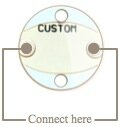 |

|
The accelerometer normally measures movement, but if you connect these two holes, it will detect 1 of 6 orientations. Tutorial coming soon. |
|
With this switch, Chiclet can react to your touch. You can also connect the hole on the side to a patch of conductive cloth to create a larger touch pad.
|

|
 |
Because sensors need to communicate with Chiclet, we have to use lightboards instead of regular LEDs or sequins. Each one has an ID (1-5), marked by the number of dots it has. Connect up to 20 in any color combination. |
|
|
How do I turn it off?
- Hold your finger to the touch pad
- After 1 second, the tiny red LED should start flashing
- Keep your finger on the touch pad for more than 1 second
- The red LED will fade off, and Chiclet will go to sleep
- Press the touch pad again to wake it up.
- Check out the video for more
|
|
How do I program it?
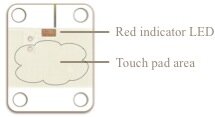
- Go to: aniomagic.com/program
- Hold your finger to the touch pad
- After 1 second, the tiny red LED should start flashing.
- Put Chiclet in front of the icon on the screen and click send.
updated video coming soon
|
|
It doesn't enter programming mode
The touch pad measures the capacitance in your finger. It might help to use a needle or paperclip for better contact. Moistening your finger works too. |
|
It's not getting new programs from the screen
- Hold Chiclet closer to the screen.
- Make the screen brighter or change the contrast.
- Dim the lights; a brightly lit environment overpowers the sensor.
- If your web browser is playing a video or doing some other activity, it throws off the timing.
Close all other browser windows and see if this solves the problem.
|
|
What kind of programs can I create?
There are two ways to program Chiclet:
- Making choices from the programming menu
- Writing textual programs
Choose a flashing pattern and speed from the NORMAL side. Then choose a pattern, speed, and repetition from the SPECIAL side.
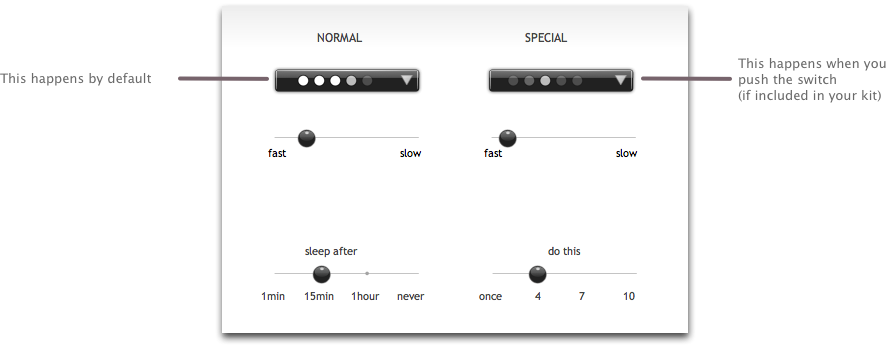
To make Chiclet act like a sensor meter (turn on more lights when there's lounder sound or higher temperatures), choose this screen.

| Detect a wide range, like completely dark to very bright. |
Detect a small range, like changes in room temperature. |
Set a high threshold, so Chiclet responds only when it gets really loud. |
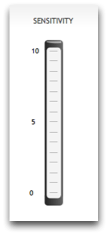 |
 |
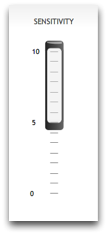 |
You can also write programs in the textual programming language, for example:
(always
(if (touched)
(twinkle 2)
(center 30)) |
(always
(if (> sensor 5)
(twinkle 2)
(center 30)) |
This tells Chiclet to do the twinkle action when you touch the touch sensor,
otherwise glow its center light slowly (30-second duration). |
This tells Chiclet to do the twinkle action when the sensor level rises above 5, otherwise glow its center light slowly (30-second duration). It doesn't matter if it's a sound sensor, light sensor, or accelerometer; the lights will flash when the level of sound, light, or motion rises above a certain threshold (the minimum is 1 and the maximum is 10). |
Get more in-depth with programming.
|
|
How long does it run?
| # lights |
CR1220
40mAh |
CR2016
130mAh |
CR2032
250mAh |
AAA
750mAh |
LiPo
1000mAh |
AA
1500mAh |
current |
| 5 |
- |
8 hours |
18 |
36 |
80 |
120 |
45mA |
| 10 |
- |
3 hours |
15 |
24 |
72 |
90 |
70mA |
| 20 |
- |
- |
- |
16 |
48 |
36 |
130mA |
| 40 |
- |
- |
- |
12 |
16 |
18 |
180mA |
|
|
What are the LED characteristics (volts / brightness / wavelengths)?
LED
color |
Dominant
wavelength |
Luminous
intensity (IF=20mA) |
Relative
brightness |
Forward
voltage |
Current
@3V |
Resistor
on board |
| diamond (white) |
X=0.285, Y=0.295 |
260mcd |
1.0 (basis) |
3.1V |
20mA |
100Ω |
| emerald (green) |
530nm |
300mcd |
1.2x |
2.8V |
25mA |
150Ω |
| amethyst (purple/uv) |
380nm |
80mcd |
0.3x |
3.2V |
15mA |
27Ω |
| sapphire (blue) |
470nm |
290mcd |
1.1x |
3.1V |
20mA |
100Ω |
| rose quartz (pink) |
---- |
110mcd |
0.4x |
3.2 |
15mA |
27Ω |
| fire opal (orange) |
640nm |
300mcd |
1.2x |
2.4V |
20mA |
100Ω |
| citrine (yellow) |
590nm |
280mcd |
1.1x |
2.6V |
20mA |
100Ω |
|
|